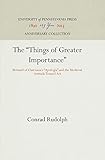The "Things of Greater Importance" : Bernard of Clairvaux's "Apologia" and the Medieval Attitude Toward Art / Conrad Rudolph.
Material type: TextPublisher: Philadelphia : University of Pennsylvania Press, [2016]Copyright date: ©1990Edition: Reprint 2016Description: 1 online resource (404 p.) : 36 illusContent type:
TextPublisher: Philadelphia : University of Pennsylvania Press, [2016]Copyright date: ©1990Edition: Reprint 2016Description: 1 online resource (404 p.) : 36 illusContent type: - 9780812281811
- 9781512806410
- 704.9/482/0940902 20
- N7850
- online - DeGruyter
| Item type | Current library | Call number | URL | Status | Notes | Barcode | |
|---|---|---|---|---|---|---|---|
 eBook
eBook
|
Biblioteca "Angelicum" Pont. Univ. S.Tommaso d'Aquino Nuvola online | online - DeGruyter (Browse shelf(Opens below)) | Online access | Not for loan (Accesso limitato) | Accesso per gli utenti autorizzati / Access for authorized users | (dgr)9781512806410 |
Browsing Biblioteca "Angelicum" Pont. Univ. S.Tommaso d'Aquino shelves, Shelving location: Nuvola online Close shelf browser (Hides shelf browser)

|

|

|

|

|

|

|
||
| online - DeGruyter The Pennsylvania Constitution of 1776 : A Study in Revolutionary Democracy / | online - DeGruyter Pioneering in Penology : The Amsterdam Houses of Correction in the Sixteenth and Seventeenth Centuries / | online - DeGruyter Blacks in the Law : Philadelphia and the Nation / | online - DeGruyter The "Things of Greater Importance" : Bernard of Clairvaux's "Apologia" and the Medieval Attitude Toward Art / | online - DeGruyter Carnival of Repetition : Gaddis's "The Recognitions" and Postmodern Theory / | online - DeGruyter A Crack in the Mirror : Reflexive Perspectives in Anthropology / | online - DeGruyter Writing Cultural History in Colonial and Postcolonial India / |
Frontmatter -- Contents -- Preface -- 1. Introduction -- 2. The "Things of Greater Importance" -- 3. The Apologia and the Art of the Orders of Cluny and Citeaux -- 4. To Whom the Apologia Was Addressed -- 5. Conclusion -- Appendix 1. The Origin of the Apologia -- Appendix 2. The Text and Translation of the Apologia With Art Historical Commentary -- Bibliography -- Illustrations -- Index
restricted access online access with authorization star
http://purl.org/coar/access_right/c_16ec
The "Things of Greater Importance" provides a close look into the social and cultural context of medieval art, primarily as expressed in Bernard of Clairvaux's Apologia, the central document in the greatest artistic controversy to occur in the West prior to the Reformation and the most important source we have for understanding medieval attitudes toward art. Bernard wrote the Apologia during the medieval efflorescence of monumental sculpture and stained glass, of advanced architecture, of pilgrimage art, of high Romanesque, and of the origins of Gothic art. Rudolph places the Apologia, traditionally seen as a condemnation either of all religious art or of all monastic art, in a broader context, using it to explore the role of art in medieval society. He shows that Bernard was interested in the impact of art on contemporary monasticism in a more complex way than previously believed. The book offers the most thorough study available of the theoretical basis of medieval art as it functioned in society; and its implications for the art of both the Romanesque and Gothic periods, which were spanned by Bernard's life, are significant.
Mode of access: Internet via World Wide Web.
In English.
Description based on online resource; title from PDF title page (publisher's Web site, viewed 23. Jul 2020)


